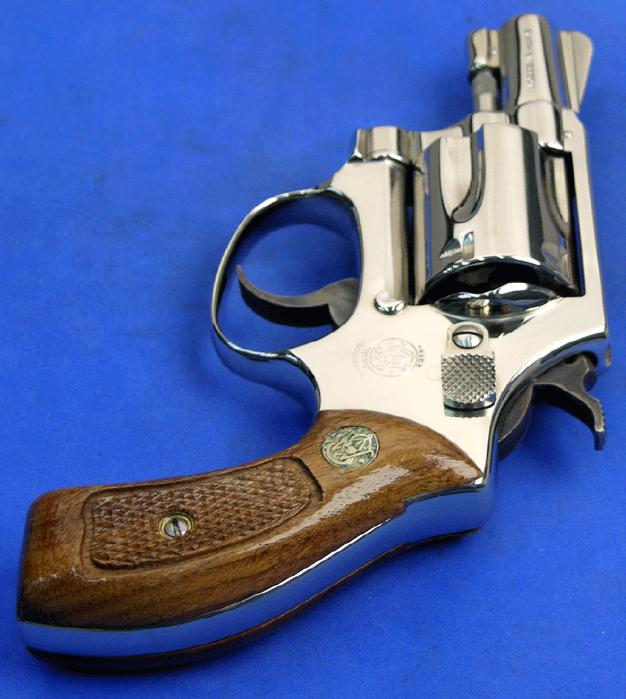Smith And Wesson Model 37 Airweight Serial Numbers
- My friend has an S&W airweight that his father in law left him. The Sheriff's office told him the model 38 airweight hammerless needs to be forwarded for destruction because the serial number is partially worn away.
- Model number and value of S&W airweight. Can't help much because Smith & Wesson made several. This would make it a 'Chief's Special Airweight' or a 'pre model 37'.

Oct 8, 2011 - I just aquired a S&W model 37 airweight and I would like to find the date of manufacture. The serial number on the butt of the gun is 77J953 Any.
 Jump to navigationJump to search
Jump to navigationJump to search| Smith & Wesson Model 12 | |
|---|---|
| Type | Revolver |
| Place of origin | United States |
| Production history | |
| Manufacturer | Smith & Wesson |
| Specifications | |
| Weight | 19 oz (524 grams) |
| Cartridge | .38 Special |
| Caliber | .38 |
| Action | double-action |
| Feed system | 5 or 6 round cylinder |

The Smith & Wesson (S&W) Model 12 is .38 Specialrevolver on Smith & Wesson's medium-sized K-frame. It is an aluminium alloy-frame version of the Model 10 (also known as the M&P). Ids software license subscription. It was made from 1953 to 1986 in both two-inch (50.8 mm) and four-inch (101.6 mm) barrel configurations. It weighs 19 oz (524 g) unloaded. Early models used an aluminum cylinder as well as frame.
Ithaca Model 37 Featherlight
Production variants[edit]
Smith Model 37
In 1953, the United States Air Force (USAF) ordered a variant of the S&W Military & Police Airweight with a two-inch barrel and aluminum cylinder to be issued to US Air Force flight crew members, called the Revolver, Lightweight, Caliber .38 Special, M13.[1][2] Some 40,000 Smith & Wesson M13 revolvers were produced.[2] After persistent reports on cylinder and frame failure with the M13 and its counterpart, the Colt Aircrewman, the Air Force attempted to remedy the issue by issuing a dedicated low-pressure .38 cartridge for the weapons—the Caliber .38, Ball, M41 round.[3] However, after continued negative reports, Air Force officials decided that the revolvers were not suitable for issue, and the model was withdrawn from service, all but a few examples being crushed or destroyed.[2]
A civilian model of the M13 was released in 1953, called the Military & Police Airweight. This designation was changed in 1957 to the Model 12 Airweight.[1] The Military & Police Airweight initially used both an aluminum cylinder and frame, and weighed only 14.5 ounces.[1] The aluminum cylinder proved insufficiently strong to withstand continued firing with standard .38 Special cartridges, and in 1954, S&W changed over all new production Airweight revolver cylinders to steel, increasing the weight to 18 ounces.[1]
The Model 12 variants 12-1, 12-2, and 12-3 used a narrower hammer[4] and had an aluminum grip frame that was 0.08-inch (2.0 mm) narrower than the standard steel K-frame.[1] The final version, the Model 12-4, used the standard frame dimension[5] of the other K-frames. It also featured a rounded butt.
- Pre-Model 12: predates model number markings. It has an alloy cylinder and will be a five-screw design with four sideplate screws and a screw in front of the trigger guard.
- Model 12 (1957):
- -1 (1962): Change extractor rod to LH thread, eliminate screw in front of trigger guard
- -2 (1962): Front sight changed from 1/10″ to 1/8″
- -3 (1977): Gas ring on yoke to cylinder
- -4 (1984): Change frame thickness to same as all K frames[citation needed]
Product development and usage[edit]
Since the Model 12 uses an alloy frame, it is not advisable to use +P ammunition since the frame may stretch during shooting. This is apparent when the primers have elongated firing pin marks. Very early versions have aluminum cylinders and should not be fired.
The two-inch barrel Model 12 is also called a snub-nose. Detectives and others with licenses to carry find snubnosed revolvers, such as the vintage Model 12, concealable, lighter in weight than their longer-barreled twins, and in an emergency, easy to deploy with their trim wood grips and round butt. The Model 12 is also a proven performer as a back-up pistol for some officers, who carry a larger caliber pistol at their waist.
The Model 12 is most often found to have some wear on its bluing due to age, but this wear does not detract from either its function or its value as a vintage concealed-carry piece. An important earmark is the factory stamp Mod-12 on the frame inside the yoke. Also on the inside of the yoke is the revolver's serial number, which is repeated verbatim on the base of the butt. The Model 12 holds its market value nicely and is highly collectible. As with most older revolvers, a reputable gunsmith should check its functioning prior to purchase.
References[edit]
- ^ abcdeScarlata, Paul (2010-09-23). 'Smith & Wesson's Model 12 Airweight'. Shooting Times. Retrieved 2017-09-11.
- ^ abcBoorman, Dean K (2002). The History of Smith & Wesson Firearms. Lyons Press. pp. 63–64. ISBN1-58574-721-1.
- ^TM 43-0001-27, Army Ammunition Data Sheets - Small Caliber Ammunition, FSC 1305, Washington, D.C.: Dept. of the Army, 29 April 1994: The standard .38 ball M41 cartridge first issued in 1956 had a pressure limit of only 13,000 CUP for a bullet velocity of 725 ft/s (221 m/s). After the M13 was withdrawn from service, a higher-pressure cartridge, the Caliber .38 Ball, Special, M41 was introduced. The M41 Special cartridge had a revised pressure rating of 16,000 CUP, giving a velocity of 950 ft/s (290 m/s).
- ^The earlier Models 12-1, 12-2, and 12-3 used a 0.240″ hammer, compared to the 0.265″ wide hammer of the standard Model 10.
- ^Camp, Stephen A., Shooting the S&W Model 12, retrieved 3 April 2011